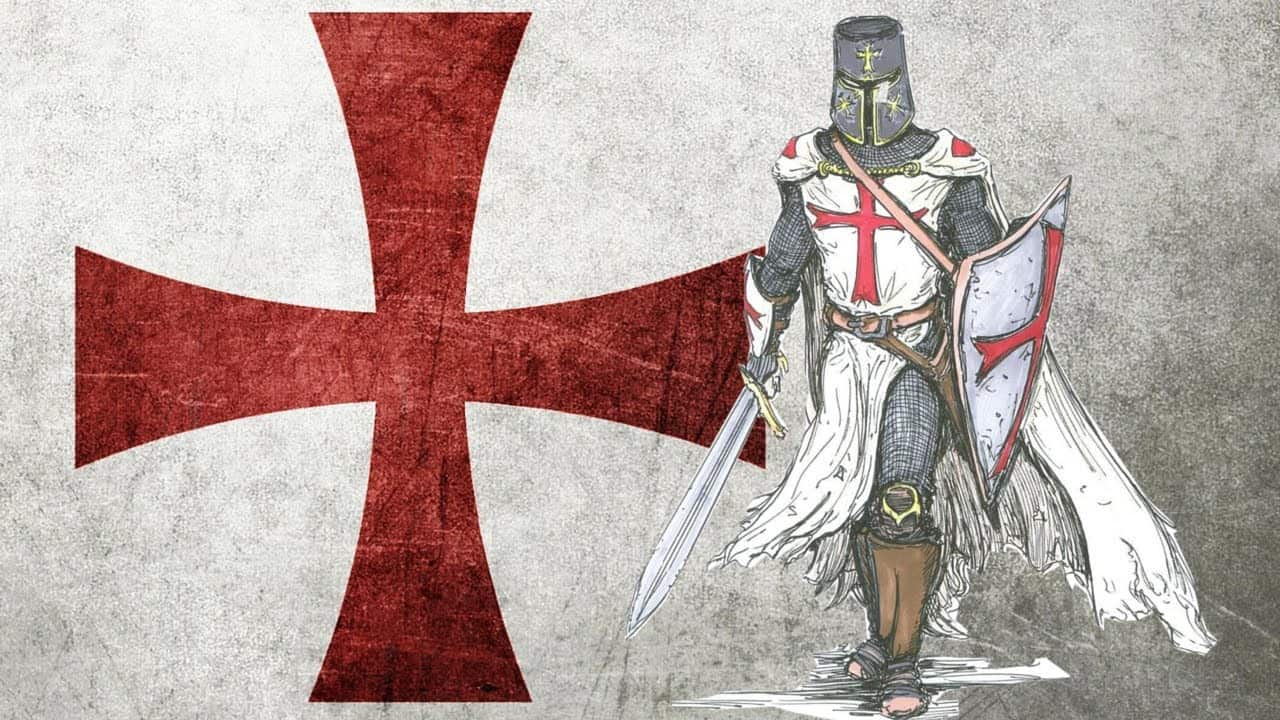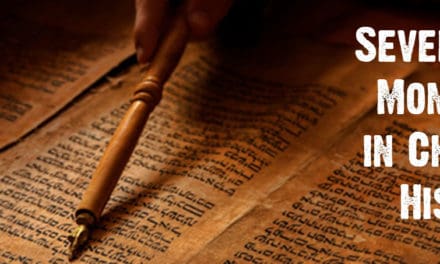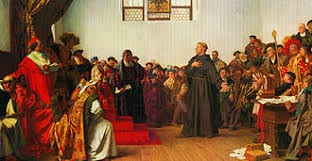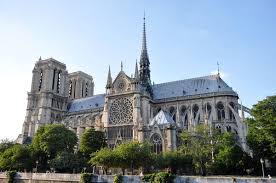Years ago I watched a TV show with fascination as the host, james Burke, started with a single item then over the course of the next hour, showed it’s link to something else, then that to something else, until after a dozen seemingly disconnected links it arrived at some marvel of modern convenience and daily life. The show was called Connections. It’s one of several things that stoked my love of history.
So, we start this episode with someone who at first blush, has nothing to do with where we’ll end. But Joachim of Fiore provides a single piece of complex system that led to one of the biggest controversies and surprises of the European Middle Ages.
Joachim was an Italians lad who after a trip to the Holy Land returned to Italy to Join the Cistercian monks. He was ordained a priest in 1168, & in 1177 was made abbot of a monastery in Corazzo. He stayed 14 yrs, then left to start a new order in Fiore.
Joachim is one of many who would never have been known to history were it not for his innovative ideas about history & eschatology. He set forth all history as belonging to 3 overlapping circles.
The Age of the Father roughly corresponds to the time of the OT. The Age of the Son he calculated to be 42 periods of 30 yrs each starting with the birth of Christ and running till the yr AD 1260. Then would commence the Age of the Spirit which would be marked by a complete revamping of human society. The Church would succeed in its task of world evangelism, not only seeing most people saved, but infiltrating human institutions to effect world-wide societal reform that would make the current system of Medieval Church hierarchy useless – Pointless. What needs is there of a special priesthood when every believer possessed the same awareness of God & compliance with His perfect will?
While Joachim has many supporters, the Pope, cardinals and archbishops weren’t thrilled and had Joachim’s ideas squashed in 1263 at the Synod of Arles. (our-l)
Joachim’s theory of history was developed against the backdrop of that Long Road to Reform we spent many episodes on in Season 1. And just because his ideas were officially quashed, that didn’t mean everyone immediately erased them form their minds. Just the opposite. They continued on in the thinking of many, especially in a branch of reform-minded Franciscans. If the current system of Church hierarchy was about to pass away in favor of a more democratic system, why not move toward that now? Why Wait?
You see, over the previous couple centuries, the Papacy had made itself into a secular government, claiming a divine mandate to do so. Religious doctrine was merged with political theory. When HR Emperor Frederick II asserted the sovereignty of the State and refused Pope Innocent IV’s political claims, he was declared a heretic. But political rulers are usually able to find loyal priests upset with their ecclesiastical superiors who are more than happy to make a counter charge of heresy against the Pope. Politics makes strange bed-fellows.
So, it’s no wonder that the political tug of war between popes and kings would led to outright combat. When at the dawn of the 14th C, Pope Boniface VIII issued the famous Unam Sanctam, claiming every human being had to obey him to be saved, then went on a crusade against any and all church officials who opposed him, King Philip IV of France decided it was time for some Pope Smack Down. Philip seized Boniface and incarcerated him. Commoners rallied and managed to free him from the King’s guards but Boniface was a broken man and died shortly after. To justify the harsh treatment the pope’d been given, Philip started up a posthumous investigation into heresy. The next pope, Clement V, managed to end the hearings but forever lived under the shadow and threat of Philip’s wrath. That became painfully clear by his participation in one of the most spectacular heresy actions of the Middle Ages. Unlike most such investigations, it didn’t involve a single individual or even small group. It took n an entire religious order: The Poor Knights of Christ and of the Temple of Solomon; better known as the Knights of the Temple, the Templars.
The Crusades of the 12th C didn’t create the 3 main military orders of Templars, Hospitallers and Teutonic Knights, but the Crusades did certainly provide them the boost that made them the fixtures of European Society they became. The Templars were founded in 1128, their rule penned by the famous Bernard of Clairvaux. While all three orders have fascinating histories, the Templars were the most colorful, richest, and most powerful of the 3 orders. They were formed to protect Christians making pilgrimage to the Holy Land and seemingly served that purpose well in their early days. But they were brutally suppressed in a spectacular police action in Europe later. While the real reason for their suppression was political, with a heavy dose of greed on Philip’s part, the official charge against them was “heresy.”
As with so many other persons and movements that run afoul of official church hierarchy, the history of the Templars is obscured by a thick coat of dubious charges. From the 12th C, the Templars were in heated competition with the Hospitallers for relevance in the Holy Land. The Templars originally laid claim to Jerusalem and its environs while the Hospitallers settled into other Crusader-occupied regions. When the Muslims reconquered Jerusalem the Templars tried to take over some the Hospitaller holdings. Blood was spilled. The Templars weren’t able to get a foothold, so they returned to Europe. Rumor had it while in Jerusalem they’d stumbled on a vast hoard of ancient treasure and were fabulously rich. No one had seen this treasure, but it became common knowledge the Templars were now the custodians of King Solomon’s vast wealth. Now, for sure, the Templars had amassed much wealth in their conquest of Jerusalem, but the rumor of untold treasure was a fiction.
What kept the rumor alive was the fact the Templars had become bankers of the extended realms taken in the First Crusade. They set up hundreds of depositories of their wealth all across Europe and the Near East with centers in London & Paris. As the Crusading Cause progressed some European nobles headed out on a Crusade placed their assets under Templar management till their return. It wasn’t long before the Templars were stewarding vast sums. In 1150 they began issuing letters of credit for pilgrims headed to the Holy Land. Before leaving, a pilgrim would deposited their valuables at one of the hundreds of Templar forts and receive a document marking the value of their deposit. When they arrived at their destination, they then exchanged this document at one of the Templar forts there for treasure of equal value. It was an early form of banking and was most likely the first official system to use checks. It vastly enhanced the safety of pilgrims since it made them less appealing targets by bandits.
The Templars set up financial networks across Christendom. They secured large tracts of land in Europe and the Near East they made into farms, vineyards & built impressive fortifications as bastions of strength to house their wealth and symbols of their power, all of which added to the sense the Templars were worth trusting in to keep your valuable safe while you were Away Crusading. They got into manufacturing and into trade in the import-export business. They had their own fleet of ships & at one point owned the island of Cyprus. Some have called the Knights Templar History’s First Multinational Corporation.
In 1305, Pope Clement V sought to affect a reconciliation btwn the feuding Templars & Hospitallers. He invited the leaders of both Orders to meet and hammer out a compromise that would see them merge into a single Order. Neither was interested but Clement persisted. A year later, the Grand Masters were set to meet with the Pope again. Jacques de Molay, the Templar leader arrived first. The Hospitaller leader, de Villaret, was delayed for several months. While de Molay waited, he & Clement got to talking about a scandal that had spun up 2 yrs before due to the charges of an ousted Templar knight. This knight, in prison awaiting a death sentence, had shared a cell with a French adventurer and confided to him some of the secret and scandalous shenanigans Templars engaged in. When the adventurer was released, he made his way to the King of Aragon’s court where he reported what he’d supposedly heard. The King of Aragon rejected the report as the scurrilous claims of a mountebank. But, the charges of heresy and immorality in the Order were too juicy not to spread. Spread they did, though most people dismissed them as absurd. The Pope brought these charges up with de Molay now as they waited for De Villaret to arrive. He wanted to see what the Templar leader would say. You see, Pope Clement was beholden to France’s King Philip IV and knew the king was in deep debt to the Templars for loans he’d taken out to fund a military campaign against the English. Seeing an opening in de Molay’s reply to the charges, Clement invited Philip to use his resources in investigating the claims made against the Templars.
France’s aging King Philip IV desperately wanted the rumor of vast Templar treasure to be true. That desire morphed into a convinced belief the Templars were sitting on a secret hoard of piles of gold and precious gems. Keeping it secret could mean only one thing; they planned to use it for nefarious purposes. And what could be more nefarious than overthrowing the crown and taking up the rule of France? After all, the Templars were a well-organized fighting force, and had been dispossessed as rulers in the Middle East. Being a royal and having tasted power, Philip projected his own political avarice onto the Templars and assumed they’d hatched a conspiracy to take over. It was just a matter of time. So he decide to strike first and pressed the Pope to initiated heresy charges against them. He was more than happy to provide the muscle to investigate the claims. But this was at a time when a charge of heresy, while damning, was also coming more frequently and didn’t have the same shock value it once did. So Phil doubled down and added to the charge of heresy, the accusation the Templars practiced gross immorality. Particularly damning at that time was the charge of rampant homosexuality.
The Templars had no means by which to refute the charges. Being a rather secretive organization, they had no public relations program or propagandists to counter Philip’s charges. What sealed their doom was Philip’s clever manipulation of Pope Clement V, who at that, time ruled from the French city of Avignon, to assign the Inquisition to investigate the charges.
In Oct of 1307, on Friday the 13th Philip ordered the Templar Grand Master Jacques de Molay and dozens of Templars arrested. Templars were accused of blasphemous initiation rites in which recruits spat on the Cross, denied Christ, and engaged in sodomy. They were charged with financial corruption, fraud, and conspiracy. As the Inquisition went to work, they secured numerous confessions substantiating the charges. Then it became known torture was being liberally applied. Commoners, shocked at the initial reports and admission of Templar wickedness, quickly turned against the Inquisitors when their methods for securing confessions became known. But public opinion had little impact of either King or Pope. Yielding to Philip’s pressure, Clement issued a papal bull just a month after De Molay’s arrest instructing all European rulers to arrest Templars and seize their assets. It seems at this point, Clement had second thoughts & decided to help the Templars if he could. He had the Inquisition stand down and called for a special papal hearing to determine the Templars’ guilt or innocence. Now free of torture, most Templars recanted their previous confessions. Philip saw the moment slipping away and in 1310 maneuvered his hand-selected Archbishop into the lead of the investigation. The previous confessions were then used to have dozens of Templars burned at the stake in Paris.
Philip threatened to have the Pope removed by force of arms if he didn’t go along with his campaign against the Templars, so Clement agreed to disband the Order. At the Council of Vienne in 1312, he issued a papal bull, Vox in excelso, dissolved the Knights Templars. Another bull assigned Templar assets to the Hospitallers, after Philip had a chance to take a health slice on the sly.
The elderly Templar Grand Master Jacques de Molay, who’d confessed under torture, retracted his confession as did a number of other Templar leaders. But they were all condemned and were burnt at the Stake in Paris in 1314. De Molay was defiant to the end, asking to be tied in such a way he could face the cathedral of Notre Dame, holding his hands in the posture of prayer. It’s reported that as the flames rose up around him he called out – “God knows who is wrong and has sinned. Soon a calamity will occur to those who have condemned us to death.” Pope Clement died a month later, and Philip was killed in a hunting accident before year was out.
Remaining Templars were arrested and tried but few were convicted. They were absorbed into either the Hospitallers of Teutonic Knights, or they retired.
In 2001, a manuscript dated to 1308 called the Chinon Parchment was discovered in the Vatican Secret Archives by Barbara Frale. It had been filed in the wrong place back in 1628. It’s a record of the Templar trial and indicates Pope Clement absolved the Templars of all heresies in 1308 before disbanding the order 4 yrs later.
Today the Roman Catholic church regards the persecution of the Templar as unjust and that there was nothing errant in either the Order rule or practice. It regards Pope Clement as having been forced by the machinations of King Philip, who, BTW, was Clement’s relative.







